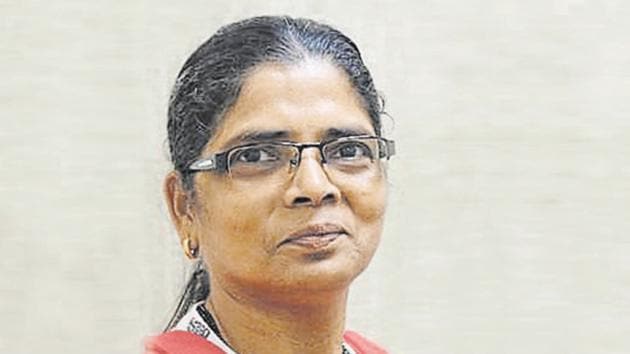‘Asymptomatic people are going undiagnosed’
Jacinta D’Souza, professor and chairperson, school of biological sciences at UM-DAE Centre for Excellence in Basic Sciences, Kalina, talks about the city turning into an epicentre of the outbreak in the state, the need for extensive testing, testing mechanisms and more.
As the lockdown continues and social distancing is observed by a large section in view of Covid-19 endemic, HT spoke to Jacinta D’Souza, professor and chairperson, school of biological sciences at UM-DAE Centre for Excellence in Basic Sciences, Kalina, on the city having turned into an epicentre of the outbreak in the state, the need for extensive testing, testing mechanisms and more.

What are the possible reasons that led to Mumbai becoming an epicentre of the outbreak?
Infection trajectories of epidemic outbreaks are multifactorial and are numerically governed by initially-infected individuals, international travellers and Covid-19 positive entries at ports (particularly in February and until March 25), population density of a region, availability of testing kits, protection of technicians/ doctors/health officials who come in direct contact with samples and/or patients, and the ability to effectively identify and quarantine ‘prospective’ super-spreaders. Networks modulate through person-to-person interaction, shared spaces/surfaces, transport/travel, and exchange of articles/items that carry the viruses. Based on this, the number of suspected individuals is high in Mumbai (and Maharashtra), thereby making it a hotspot. In addition there are ‘escapers’ who were Covid-19 positive and ‘managed’ to escape the screening system. With the lockdown being announced for a 21-day period starting 25th March, these ‘escapers’ turned into super-spreaders.
Though testing in Mumbai has ramped up, a section of experts say extensive testing is required to identify Covid-19 cases to contain the spread. What are the repercussions of inadequate testing?
Demand and supply of kits worldwide has caused paucity in testing, and hence there is a set line of priority in investigating individuals – symptomatic over asymptomatic cases. It is difficult to know the exact numbers of asymptomatic individuals that go undiagnosed in testing. Unless this subset is diagnosed with critical surveillance, we won’t be able to gauge the spread of the virus in the community.
Please explain the testing mechanisms.
Currently, there are more 200 assay kits available for detecting Sars-CoV-2 virus and these are based on two scientific premises – molecular detection of genes that are specific to the virus from naso-pharyngeal swabs, and serological detection of antibodies specifically raised by the patient’s immune system against viral proteins. While the first requires a high-throughput real-time polymerase chain reaction machine, the latter is simpler, faster and requires the patient’s blood serum. The former is slower, more sensitive and can detect viral particles immediate to an infection in the throat or nasal swab. The latter mandates the patient’s immune system to develop antibodies after an infection. Additionally, each assay kit, in principle needs the presence of internal controls for testing every sample. Another requirement is the cold-chain transportation of samples. If these are not fulfilled, false negatives are bound to take place and become an inevitable part of the process. Given this, approved diagnostic testing by Indian Council for Medical Research is majorly based on molecular detection.
What then is the way forward as far as testing is concerned?
The need of the hour is to produce a comprehensive assay kit based both on molecular and serological principles. This will require more knowledge on the virus and the infection, and will take time. Many laboratories around the world are already working in that direction.
India has laid out six criteria for testing that excludes asymptomatic individuals unless they have travelled in the last 14 years. Won’t this approach have implications in terms of underreporting of Covid-19 cases?
The World Health Organization’s Covid-19 situation report 73 suggests that the number of asymptomatic individuals, who have tested positive, has been very few and the transmission of the virus from an asymptomatic individual has yet to be documented.
Currently, the idea is to cater to those individuals who are symptomatic, the obviousness with which they can spread the infection and not to simply ‘burden’ the diagnostic laboratories/centres and hospitals.
Large number of containment zones have been created where a person tested Covid-19 positive. Only family members, neighbours and those in close contact are tested, while the remaining populace is quarantined for 14 days. Is this an effective strategy especially in densely populated areas of Worli-Koliwada and Dharavi slums with cases spiralling?
Indeed. The need to test others does not arise; if infected, they would develop symptoms during this 14-day period. A close watch and monitoring of these contacts is very important. However, in areas where the population density is very high (Dharavi, for example) the infection-spread-recovery cycle gets skewed; home quarantining might not prove to be the best solution. These contacts should be isolated from such regions and quarantined into a separate locality.
Stay updated with all the Breaking News and Latest News from Mumbai. Click here for comprehensive coverage of top Cities including Bengaluru, Delhi, Hyderabad, and more across India along with Stay informed on the latest happenings in World News.
Stay updated with all the Breaking News and Latest News from Mumbai. Click here for comprehensive coverage of top Cities including Bengaluru, Delhi, Hyderabad, and more across India along with Stay informed on the latest happenings in World News.





